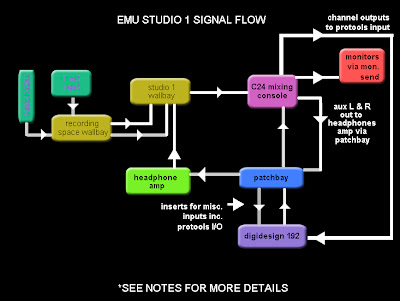
This week’s exercise involved describing the signal flow from a microphone or DI’d signal in the recording space to Pro Tools in Studio 1. To achieve this I teamed up with Sam Deere and we obtained the necessary information from the EMU (Studio) Guide, Dave Grice during the week 1 seminar and a physical inspection of Studio 1. The assignment also required a description of the talkback, headphones and studio monitors signal flows all of which should be covered by the above diagram. For extra explanatory notes, see below.
Notes:
* Patchbay inputs to Pro Tools are normalised (ie: no patchbay plugs required)
* Pro Tools outputs to patchbay are not normalised and need to be patched (Pro Tools 1 and Pro Tools 2 outputs to C24 Pro Tools source 1 and C24 Pro Tools source 2 inputs)
* For headphones mix, select monitor> auxiliary on C24
* Talkback via desk microphone, automatically patched to headphones (aux) send
* To patch a microphone or DI input via the Avalon pre-amp, the signal path between the microphone inputs at the Studio 1 wallbay is broken by inserting the dedicated Avalon input (mic signal) lead into the signal path or (for a line level signal), plug the instrument directly into the socket on the front panel of the Avalon itself – either of these options will then need to be patched on the patchbay from Avalon Out to ProTools In
References:
D.Grice, EMU Studio 1 Signal Flow, Sound Engineering Studio Lecture, 29/07/08
Adelaide University, Electronic Music Unit, Resources, Guides, Spaces, Studio 1
http://emu.adelaide.edu.au/resources/guides/spaces/studio.1.html, viewed 03/08/08

1 comment:
In the world of music production, understanding signal flow is essential for achieving high-quality recordings. The Studio 1 Signal Flow article provides a clear and concise explanation of the signal path and how each piece of equipment fits into the overall signal chain. I appreciate the use of diagrams and examples to illustrate the concepts, making it easier for beginners to follow along. Additionally, the article emphasizes the importance of gain staging and avoiding clipping, which are often overlooked by novice producers. Overall, Studio 1 Signal Flow is a valuable resource for anyone looking to improve their recording and mixing skills.I also remember that the Sound Engineering Courses in Kerala also provides a professional service similar to this.
Post a Comment